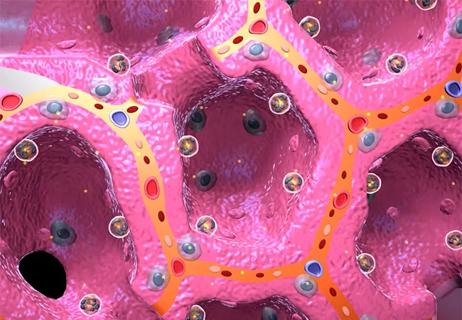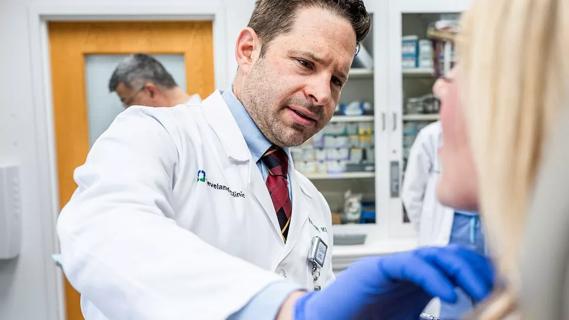Cleveland Clinic pulmonologists share a framework for how to implement effective clinical protocols to standardize evaluation and management of complex acute respiratory distress syndrome

For patients with severe acute respiratory distress syndrome (ARDS), prone position ventilation (PPV) is one intervention of care that has been shown to improve mortality significantly. The Prone Positioning in Severe Acute Respiratory Distress Syndrome (PROSEVA) trial in 2013 indicated that PPV can reduce a patient’s absolute mortality risk by 16%.1 However, one of the primary issues with PPV has been the application of prone position in clinical practice. Following the publication of the 2013 study, two large international observational studies, Large Observational Study to Understand the Global Impact of Severe Acute Respiratory Failure (LUNG SAFE) and ARDS Prone Position Network (APRONET), indicated that just 16%-33% of patients with severe ARDS underwent PPV.2,3
Advertisement
Cleveland Clinic is a non-profit academic medical center. Advertising on our site helps support our mission. We do not endorse non-Cleveland Clinic products or services. Policy
To improve PPV application rates, a recent study from Journal of Intensive Care Medicine created a framework for multidisciplinary collaboration that helps identify patients who would benefit from PPV.4 “Our study discusses both our overall experience over the last decade with how we developed this protocol, and it also outlines the primer for other places to understand the main factors to consider as they institute prone position ventilation in patients with severe ARDS,” says Abhijit Duggal, MD, a staff intensivist at Cleveland Clinic’s Respiratory Institute and corresponding author of the article.
Cleveland Clinic’s first PPV protocol was developed in the early 2000s as a nursing protocol to provide instruction for how to place patients in PP and provide care. PPV at this time was used inconsistently and for a duration of eight to 10 hours per day. But in 2009, when the H1N1 influenza pandemic occurred, the spike in severe ARDS patients lead to increased usage of PPV and helped establish it as routine adjunct therapy at Cleveland Clinic’s Medical Intensive Care Unit (MICU). This spike also led to two realizations about PPV: 1) Almost 60% of these patients were experiencing PP-associated pressure injuries, and 2) PPV was still being utilized inconsistently.
“We felt that the original PP protocol was likely the culprit for these findings,” says Dr. Duggal. “Since the protocol was primarily designed to be a tool to help nurses care for patients already determined to be good candidates for PP, it lacked specific instruction on patient selection, contraindications to PP, or guidance on how to assess response to therapy and how long PP should be utilized.”
Advertisement
He continues, “The protocol was updated to address some of these issues, but because of the lack of high-quality evidence from large trials at the time, the protocol did not include specific guidance on patient selection and management until after the PROSEVA trial in 2013. In 2014, we updated it again and moved away from mechanical PP beds to manual prone positioning as well as including prone wedges, pillows and padding after we noticed pressure injuries and airway complications associated with the mechanical beds.”
The group reviewed data from 70 patients with ARDS after the application of these changes and found that while the number of pressure-induced skin injuries decreased dramatically, mortality was still high. This was attributed to patients being treated with PPV who were outside of the inclusion criteria established in the PROSEVA trial. They also found that PPV was being incorporated into treatment as a rescue therapy late during persistent severe refractory hypoxemia or in the setting of marked hemodynamic instability.
When the group looked at the subgroup of “appropriately” selected patients, they showed that patients derived significant benefits from PP. The protocol was subsequently revised to stress the initiation of PP as an early adjunct therapy in line with its use in the PROSEVA trial and highlight selection criteria for patients most likely to benefit from PPV.
Several additional revisions were made including:
Advertisement
The initial protocol was developed, modified and consistently implemented across five medical intensive care units at just one hospital. But when the COVID-19 pandemic hit, the training and implementation accelerated dramatically.
“We implemented a train-the-trainer approach, which helped us maintain an adequate number of available instructors to make sure there was constant, uninterrupted education in target hospitals,” explains Dr. Duggal. “This approach helped rapidly expand capacity and provide educational outreach to help meet local needs during the COVID surges. This also meant that some of the earliest trained caregivers became some of the earliest champions of PPV and content experts in their respective hospitals where they could promote PP implementation.”
Between March and April 2020, more than 300 caregivers were trained in PP to prepare for COVID-19, and this is in addition to the 456 caregivers who were trained prior to the pandemic. Dr. Duggal notes of the group’s major takeaways was the importance of engaging with nursing leadership.
“When we are introducing a therapy, such as proning, one of the most critical aspects of the equation is having experienced nurses who understand how to move forward with this,” says Dr. Duggal. “You can have nursing champions who really teach others, and everyone can be a part of the team to help prone these patients. But all of this requires teaching and requires a proper implementation because otherwise you can cause harm because you won’t understand what’s the right way or the potential risk of doing something like this.”
Advertisement
Dr. Duggal says that while education is a primary piece of PPV implementation, the group identified four other aspects of a successful PPV program. These include:
Dr. Duggal notes that while the implementation of the PPV framework was successful, challenges still remain. “One thing that we are very interested in looking at is how to maintain the behavior of proning people and not go back to how it was,” says Dr. Duggal. “Presently, we are doing a lot of interventions in both teaching and training to identify potential barriers for patients with ARDS to see why providers might be at risk of going back to their previous behavior.”
References
Advertisement
Advertisement

Case study illustrates the potential of a dual-subspecialist approach

New tools and protocols to improve care

Endoscopic balloon dilation during pregnancy helps optimize outcomes

Surgery is typically the only option for the most severe cases, but a minimally invasive procedure is reducing morbidity and recovery time for patients

A public health tragedy with persistent pathophysiological and therapeutic challenges

Pearls to reduce the strain of RSV, COVID-19 and influenza infections

No effect on symptom severity or disability, and low prevalence of long COVID

Findings show profound muscle loss variance between men and women